Taxation Law and Practice Assignment - Payroll, GST, and FBT
VerifiedAdded on 2023/04/20
|9
|1649
|299
Homework Assignment
AI Summary
This assignment solution addresses a taxation law problem centered around Bronny Park, a horse-racing stable. The solution begins with the computation of payroll information and employer's superannuation obligations. It then analyzes the concept of business income, ordinary income, and allowable deductions, with references to relevant sections of the ITAA 1997 and case law such as Scott v CT and Ronpibon Tin NL v FCT. The assignment further delves into GST implications, including creditable acquisitions, and the conditions for claiming GST credits. The solution also includes calculations for GST reporting, PAYG, and FBT instalments, demonstrating a comprehensive understanding of taxation principles. The assignment is structured with clear explanations and calculations for each question, and it includes references to support the analysis.
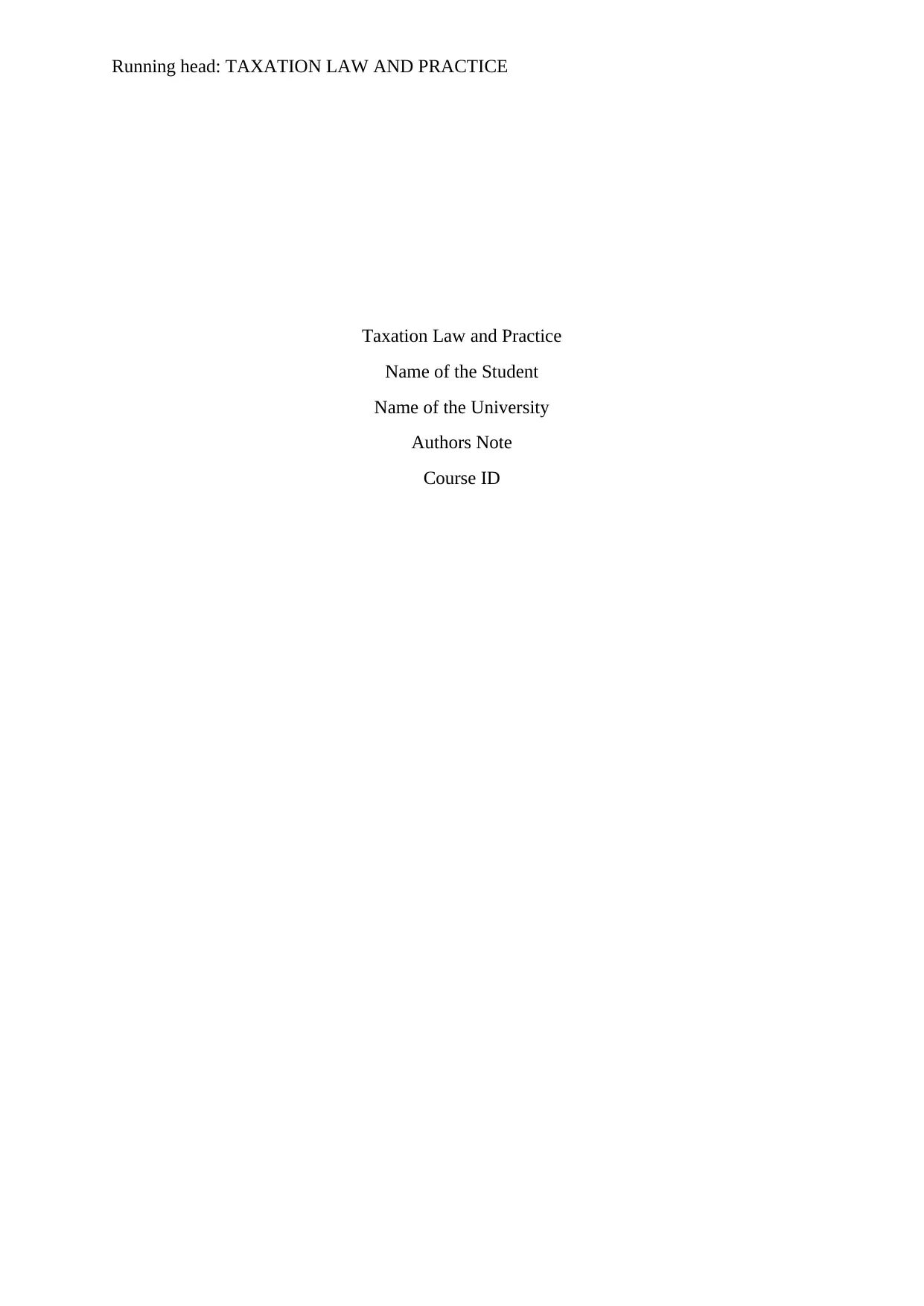
Running head: TAXATION LAW AND PRACTICE
Taxation Law and Practice
Name of the Student
Name of the University
Authors Note
Course ID
Taxation Law and Practice
Name of the Student
Name of the University
Authors Note
Course ID
Paraphrase This Document
Need a fresh take? Get an instant paraphrase of this document with our AI Paraphraser
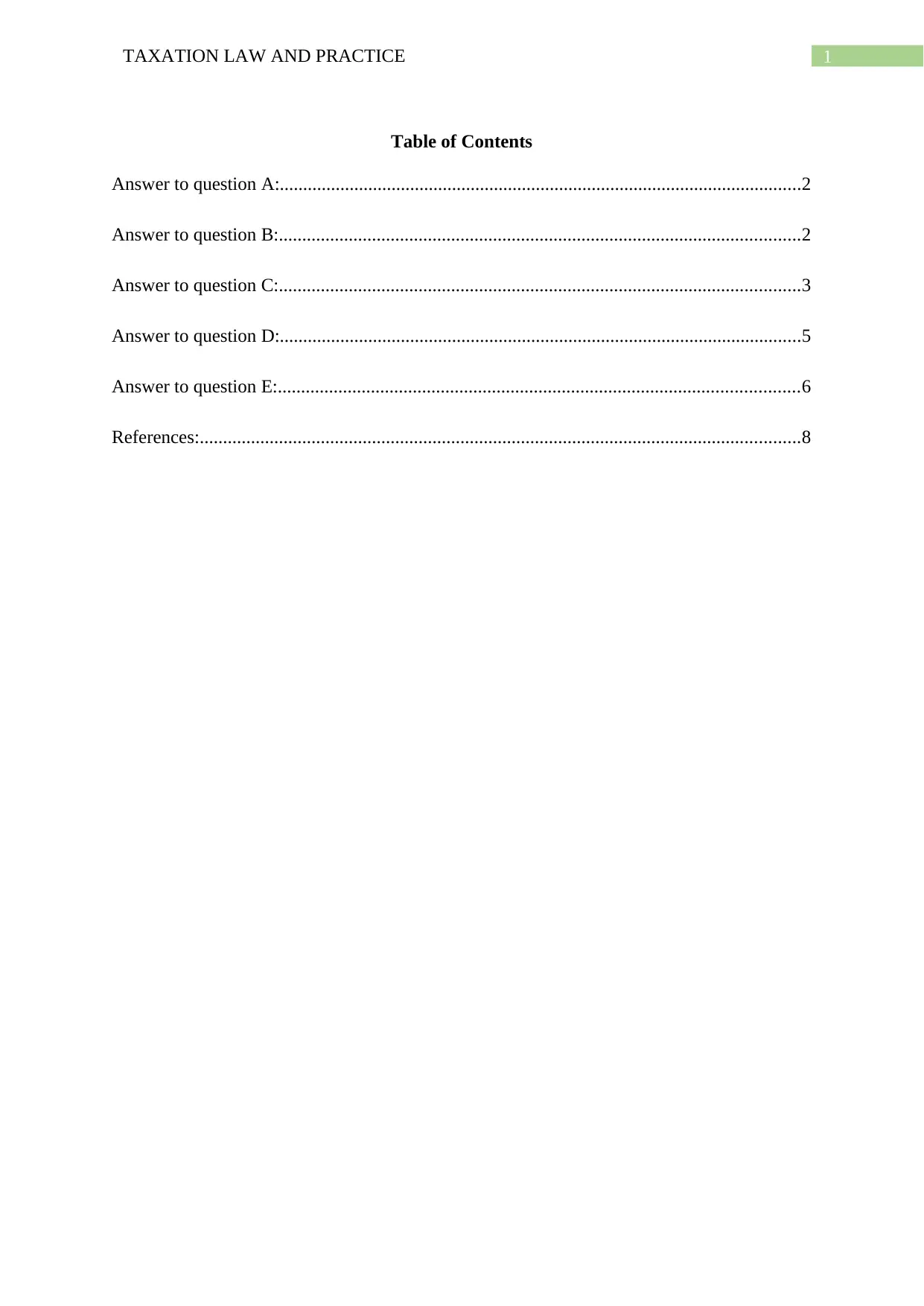
1TAXATION LAW AND PRACTICE
Table of Contents
Answer to question A:................................................................................................................2
Answer to question B:................................................................................................................2
Answer to question C:................................................................................................................3
Answer to question D:................................................................................................................5
Answer to question E:................................................................................................................6
References:.................................................................................................................................8
Table of Contents
Answer to question A:................................................................................................................2
Answer to question B:................................................................................................................2
Answer to question C:................................................................................................................3
Answer to question D:................................................................................................................5
Answer to question E:................................................................................................................6
References:.................................................................................................................................8
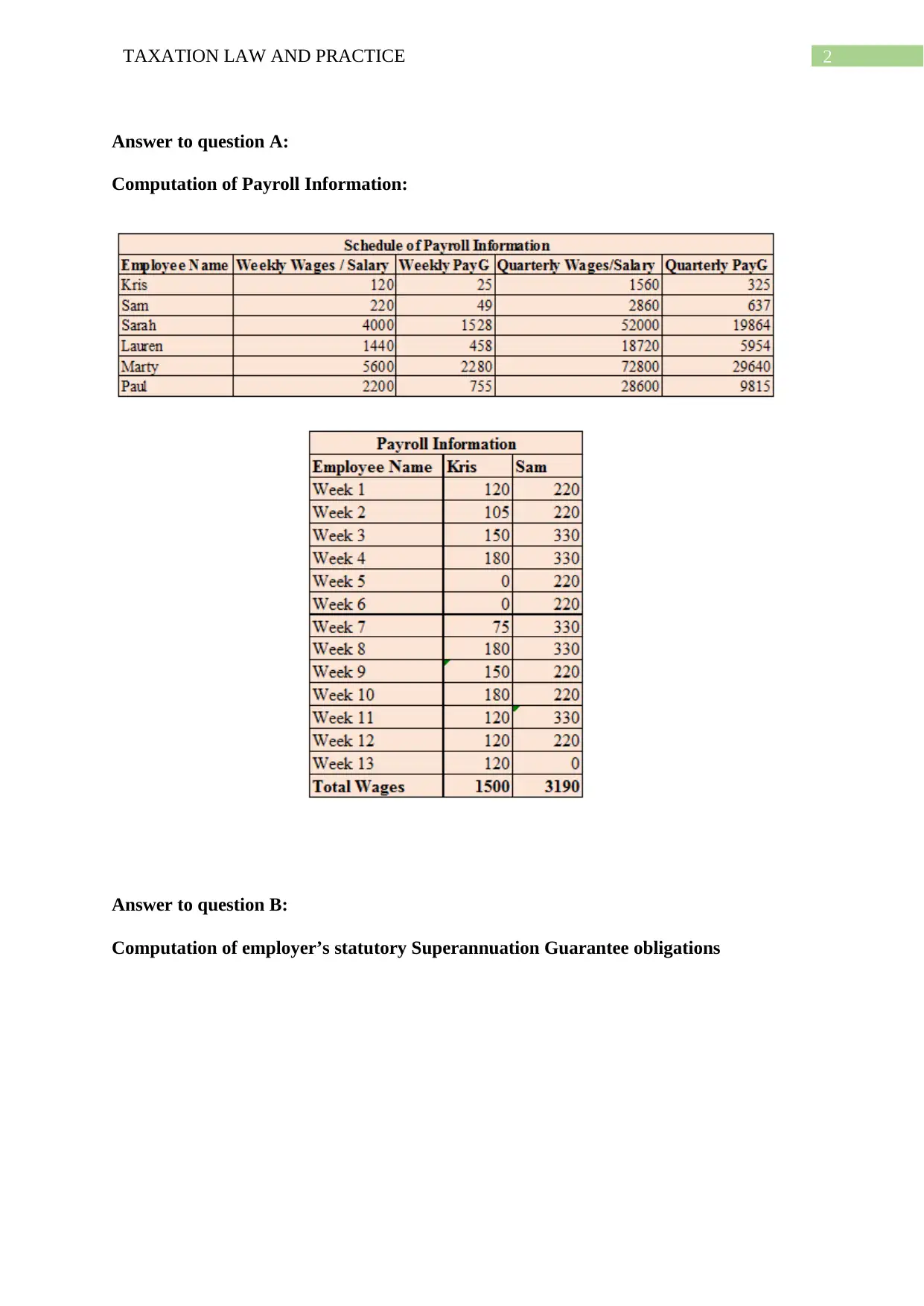
2TAXATION LAW AND PRACTICE
Answer to question A:
Computation of Payroll Information:
Answer to question B:
Computation of employer’s statutory Superannuation Guarantee obligations
Answer to question A:
Computation of Payroll Information:
Answer to question B:
Computation of employer’s statutory Superannuation Guarantee obligations
⊘ This is a preview!⊘
Do you want full access?
Subscribe today to unlock all pages.

Trusted by 1+ million students worldwide
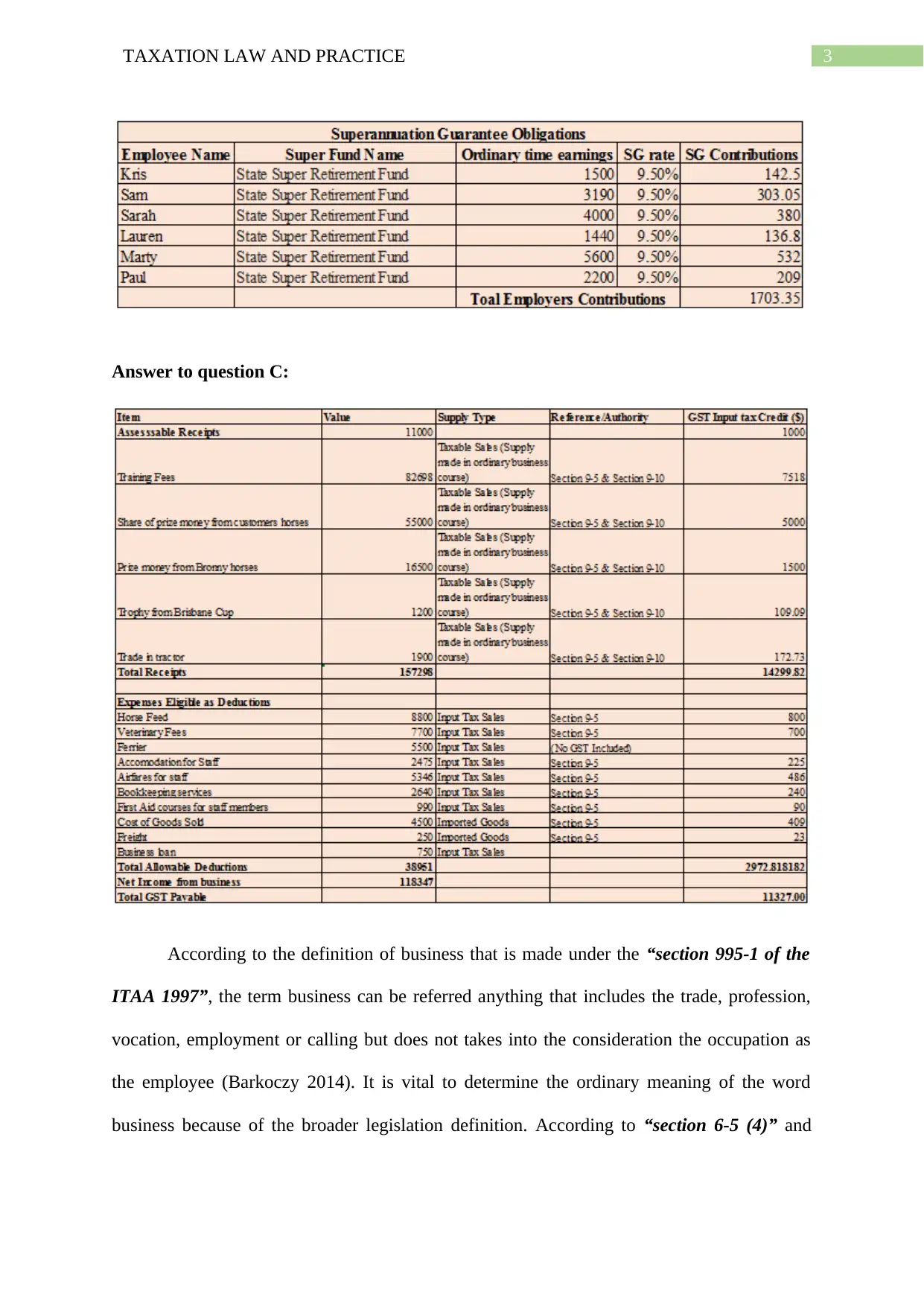
3TAXATION LAW AND PRACTICE
Answer to question C:
According to the definition of business that is made under the “section 995-1 of the
ITAA 1997”, the term business can be referred anything that includes the trade, profession,
vocation, employment or calling but does not takes into the consideration the occupation as
the employee (Barkoczy 2014). It is vital to determine the ordinary meaning of the word
business because of the broader legislation definition. According to “section 6-5 (4)” and
Answer to question C:
According to the definition of business that is made under the “section 995-1 of the
ITAA 1997”, the term business can be referred anything that includes the trade, profession,
vocation, employment or calling but does not takes into the consideration the occupation as
the employee (Barkoczy 2014). It is vital to determine the ordinary meaning of the word
business because of the broader legislation definition. According to “section 6-5 (4)” and
Paraphrase This Document
Need a fresh take? Get an instant paraphrase of this document with our AI Paraphraser
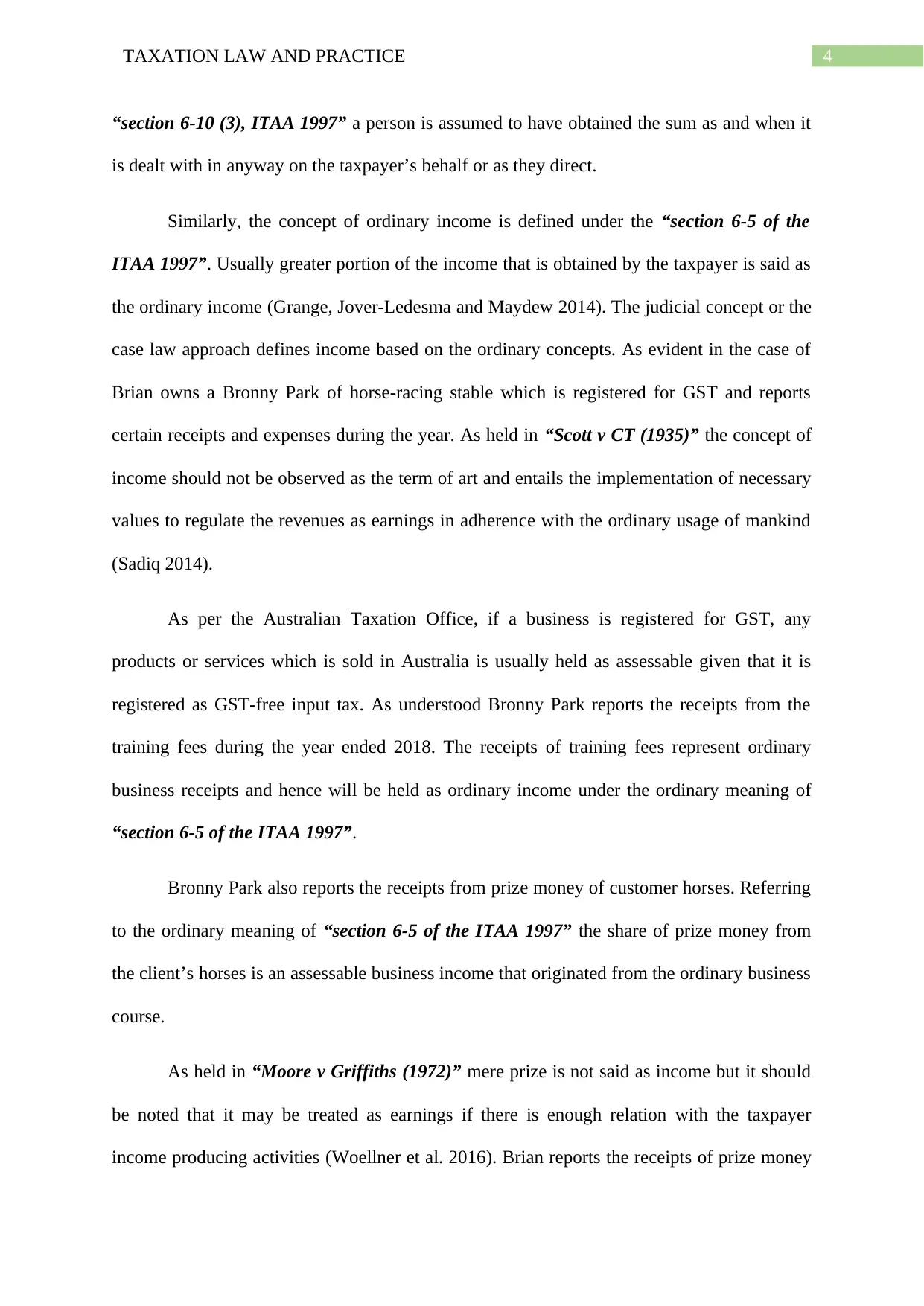
4TAXATION LAW AND PRACTICE
“section 6-10 (3), ITAA 1997” a person is assumed to have obtained the sum as and when it
is dealt with in anyway on the taxpayer’s behalf or as they direct.
Similarly, the concept of ordinary income is defined under the “section 6-5 of the
ITAA 1997”. Usually greater portion of the income that is obtained by the taxpayer is said as
the ordinary income (Grange, Jover-Ledesma and Maydew 2014). The judicial concept or the
case law approach defines income based on the ordinary concepts. As evident in the case of
Brian owns a Bronny Park of horse-racing stable which is registered for GST and reports
certain receipts and expenses during the year. As held in “Scott v CT (1935)” the concept of
income should not be observed as the term of art and entails the implementation of necessary
values to regulate the revenues as earnings in adherence with the ordinary usage of mankind
(Sadiq 2014).
As per the Australian Taxation Office, if a business is registered for GST, any
products or services which is sold in Australia is usually held as assessable given that it is
registered as GST-free input tax. As understood Bronny Park reports the receipts from the
training fees during the year ended 2018. The receipts of training fees represent ordinary
business receipts and hence will be held as ordinary income under the ordinary meaning of
“section 6-5 of the ITAA 1997”.
Bronny Park also reports the receipts from prize money of customer horses. Referring
to the ordinary meaning of “section 6-5 of the ITAA 1997” the share of prize money from
the client’s horses is an assessable business income that originated from the ordinary business
course.
As held in “Moore v Griffiths (1972)” mere prize is not said as income but it should
be noted that it may be treated as earnings if there is enough relation with the taxpayer
income producing activities (Woellner et al. 2016). Brian reports the receipts of prize money
“section 6-10 (3), ITAA 1997” a person is assumed to have obtained the sum as and when it
is dealt with in anyway on the taxpayer’s behalf or as they direct.
Similarly, the concept of ordinary income is defined under the “section 6-5 of the
ITAA 1997”. Usually greater portion of the income that is obtained by the taxpayer is said as
the ordinary income (Grange, Jover-Ledesma and Maydew 2014). The judicial concept or the
case law approach defines income based on the ordinary concepts. As evident in the case of
Brian owns a Bronny Park of horse-racing stable which is registered for GST and reports
certain receipts and expenses during the year. As held in “Scott v CT (1935)” the concept of
income should not be observed as the term of art and entails the implementation of necessary
values to regulate the revenues as earnings in adherence with the ordinary usage of mankind
(Sadiq 2014).
As per the Australian Taxation Office, if a business is registered for GST, any
products or services which is sold in Australia is usually held as assessable given that it is
registered as GST-free input tax. As understood Bronny Park reports the receipts from the
training fees during the year ended 2018. The receipts of training fees represent ordinary
business receipts and hence will be held as ordinary income under the ordinary meaning of
“section 6-5 of the ITAA 1997”.
Bronny Park also reports the receipts from prize money of customer horses. Referring
to the ordinary meaning of “section 6-5 of the ITAA 1997” the share of prize money from
the client’s horses is an assessable business income that originated from the ordinary business
course.
As held in “Moore v Griffiths (1972)” mere prize is not said as income but it should
be noted that it may be treated as earnings if there is enough relation with the taxpayer
income producing activities (Woellner et al. 2016). Brian reports the receipts of prize money
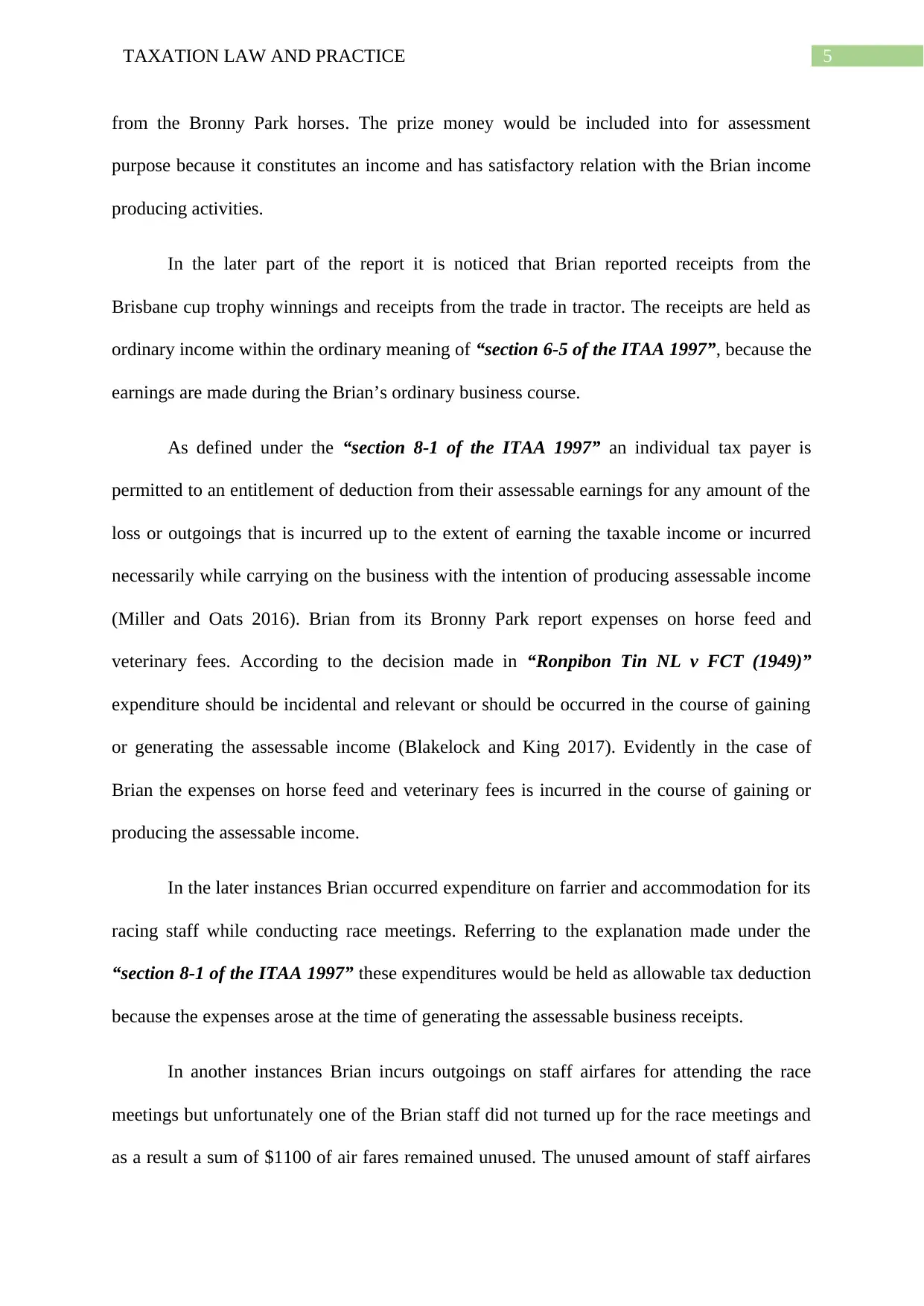
5TAXATION LAW AND PRACTICE
from the Bronny Park horses. The prize money would be included into for assessment
purpose because it constitutes an income and has satisfactory relation with the Brian income
producing activities.
In the later part of the report it is noticed that Brian reported receipts from the
Brisbane cup trophy winnings and receipts from the trade in tractor. The receipts are held as
ordinary income within the ordinary meaning of “section 6-5 of the ITAA 1997”, because the
earnings are made during the Brian’s ordinary business course.
As defined under the “section 8-1 of the ITAA 1997” an individual tax payer is
permitted to an entitlement of deduction from their assessable earnings for any amount of the
loss or outgoings that is incurred up to the extent of earning the taxable income or incurred
necessarily while carrying on the business with the intention of producing assessable income
(Miller and Oats 2016). Brian from its Bronny Park report expenses on horse feed and
veterinary fees. According to the decision made in “Ronpibon Tin NL v FCT (1949)”
expenditure should be incidental and relevant or should be occurred in the course of gaining
or generating the assessable income (Blakelock and King 2017). Evidently in the case of
Brian the expenses on horse feed and veterinary fees is incurred in the course of gaining or
producing the assessable income.
In the later instances Brian occurred expenditure on farrier and accommodation for its
racing staff while conducting race meetings. Referring to the explanation made under the
“section 8-1 of the ITAA 1997” these expenditures would be held as allowable tax deduction
because the expenses arose at the time of generating the assessable business receipts.
In another instances Brian incurs outgoings on staff airfares for attending the race
meetings but unfortunately one of the Brian staff did not turned up for the race meetings and
as a result a sum of $1100 of air fares remained unused. The unused amount of staff airfares
from the Bronny Park horses. The prize money would be included into for assessment
purpose because it constitutes an income and has satisfactory relation with the Brian income
producing activities.
In the later part of the report it is noticed that Brian reported receipts from the
Brisbane cup trophy winnings and receipts from the trade in tractor. The receipts are held as
ordinary income within the ordinary meaning of “section 6-5 of the ITAA 1997”, because the
earnings are made during the Brian’s ordinary business course.
As defined under the “section 8-1 of the ITAA 1997” an individual tax payer is
permitted to an entitlement of deduction from their assessable earnings for any amount of the
loss or outgoings that is incurred up to the extent of earning the taxable income or incurred
necessarily while carrying on the business with the intention of producing assessable income
(Miller and Oats 2016). Brian from its Bronny Park report expenses on horse feed and
veterinary fees. According to the decision made in “Ronpibon Tin NL v FCT (1949)”
expenditure should be incidental and relevant or should be occurred in the course of gaining
or generating the assessable income (Blakelock and King 2017). Evidently in the case of
Brian the expenses on horse feed and veterinary fees is incurred in the course of gaining or
producing the assessable income.
In the later instances Brian occurred expenditure on farrier and accommodation for its
racing staff while conducting race meetings. Referring to the explanation made under the
“section 8-1 of the ITAA 1997” these expenditures would be held as allowable tax deduction
because the expenses arose at the time of generating the assessable business receipts.
In another instances Brian incurs outgoings on staff airfares for attending the race
meetings but unfortunately one of the Brian staff did not turned up for the race meetings and
as a result a sum of $1100 of air fares remained unused. The unused amount of staff airfares
⊘ This is a preview!⊘
Do you want full access?
Subscribe today to unlock all pages.

Trusted by 1+ million students worldwide
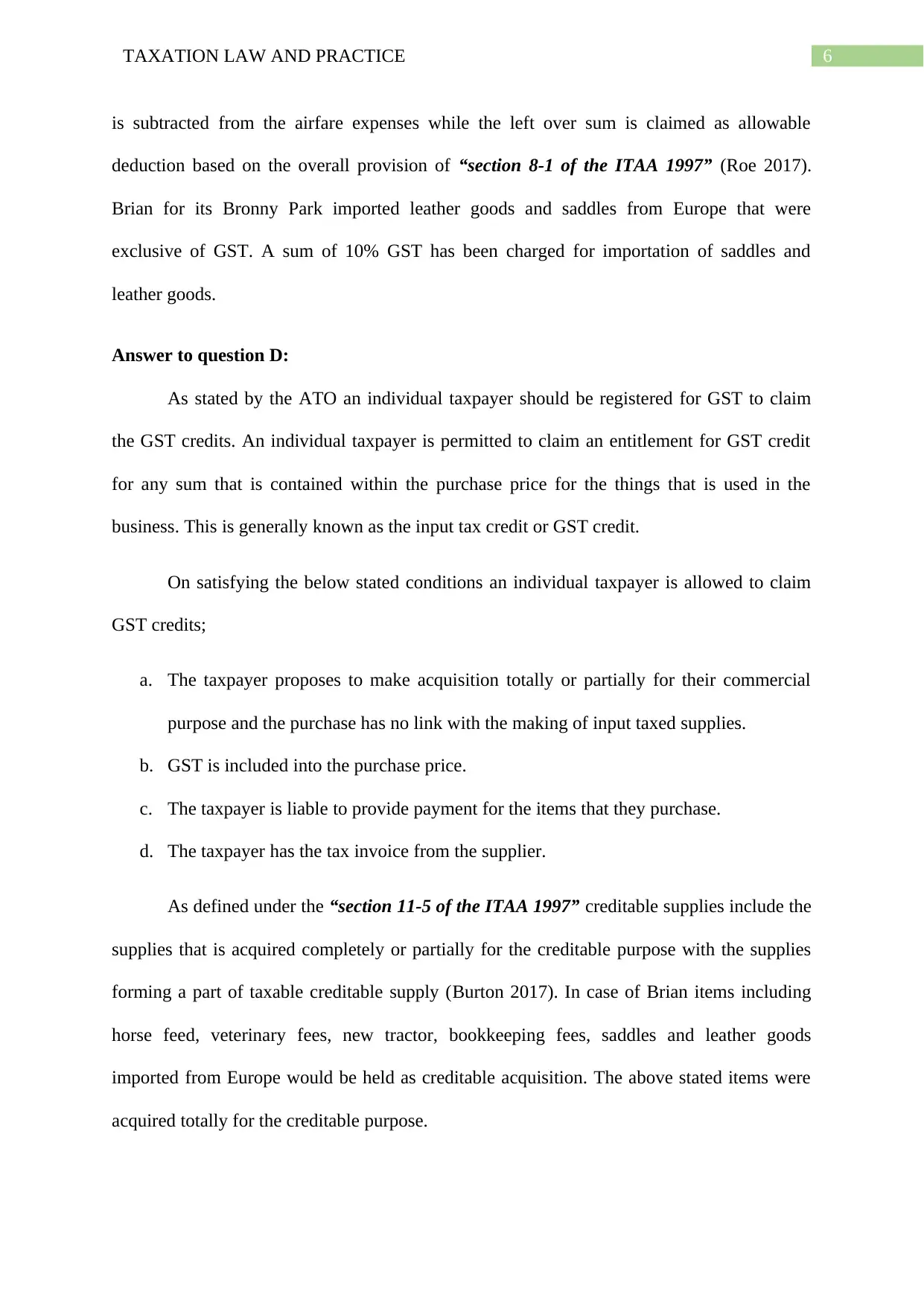
6TAXATION LAW AND PRACTICE
is subtracted from the airfare expenses while the left over sum is claimed as allowable
deduction based on the overall provision of “section 8-1 of the ITAA 1997” (Roe 2017).
Brian for its Bronny Park imported leather goods and saddles from Europe that were
exclusive of GST. A sum of 10% GST has been charged for importation of saddles and
leather goods.
Answer to question D:
As stated by the ATO an individual taxpayer should be registered for GST to claim
the GST credits. An individual taxpayer is permitted to claim an entitlement for GST credit
for any sum that is contained within the purchase price for the things that is used in the
business. This is generally known as the input tax credit or GST credit.
On satisfying the below stated conditions an individual taxpayer is allowed to claim
GST credits;
a. The taxpayer proposes to make acquisition totally or partially for their commercial
purpose and the purchase has no link with the making of input taxed supplies.
b. GST is included into the purchase price.
c. The taxpayer is liable to provide payment for the items that they purchase.
d. The taxpayer has the tax invoice from the supplier.
As defined under the “section 11-5 of the ITAA 1997” creditable supplies include the
supplies that is acquired completely or partially for the creditable purpose with the supplies
forming a part of taxable creditable supply (Burton 2017). In case of Brian items including
horse feed, veterinary fees, new tractor, bookkeeping fees, saddles and leather goods
imported from Europe would be held as creditable acquisition. The above stated items were
acquired totally for the creditable purpose.
is subtracted from the airfare expenses while the left over sum is claimed as allowable
deduction based on the overall provision of “section 8-1 of the ITAA 1997” (Roe 2017).
Brian for its Bronny Park imported leather goods and saddles from Europe that were
exclusive of GST. A sum of 10% GST has been charged for importation of saddles and
leather goods.
Answer to question D:
As stated by the ATO an individual taxpayer should be registered for GST to claim
the GST credits. An individual taxpayer is permitted to claim an entitlement for GST credit
for any sum that is contained within the purchase price for the things that is used in the
business. This is generally known as the input tax credit or GST credit.
On satisfying the below stated conditions an individual taxpayer is allowed to claim
GST credits;
a. The taxpayer proposes to make acquisition totally or partially for their commercial
purpose and the purchase has no link with the making of input taxed supplies.
b. GST is included into the purchase price.
c. The taxpayer is liable to provide payment for the items that they purchase.
d. The taxpayer has the tax invoice from the supplier.
As defined under the “section 11-5 of the ITAA 1997” creditable supplies include the
supplies that is acquired completely or partially for the creditable purpose with the supplies
forming a part of taxable creditable supply (Burton 2017). In case of Brian items including
horse feed, veterinary fees, new tractor, bookkeeping fees, saddles and leather goods
imported from Europe would be held as creditable acquisition. The above stated items were
acquired totally for the creditable purpose.
Paraphrase This Document
Need a fresh take? Get an instant paraphrase of this document with our AI Paraphraser
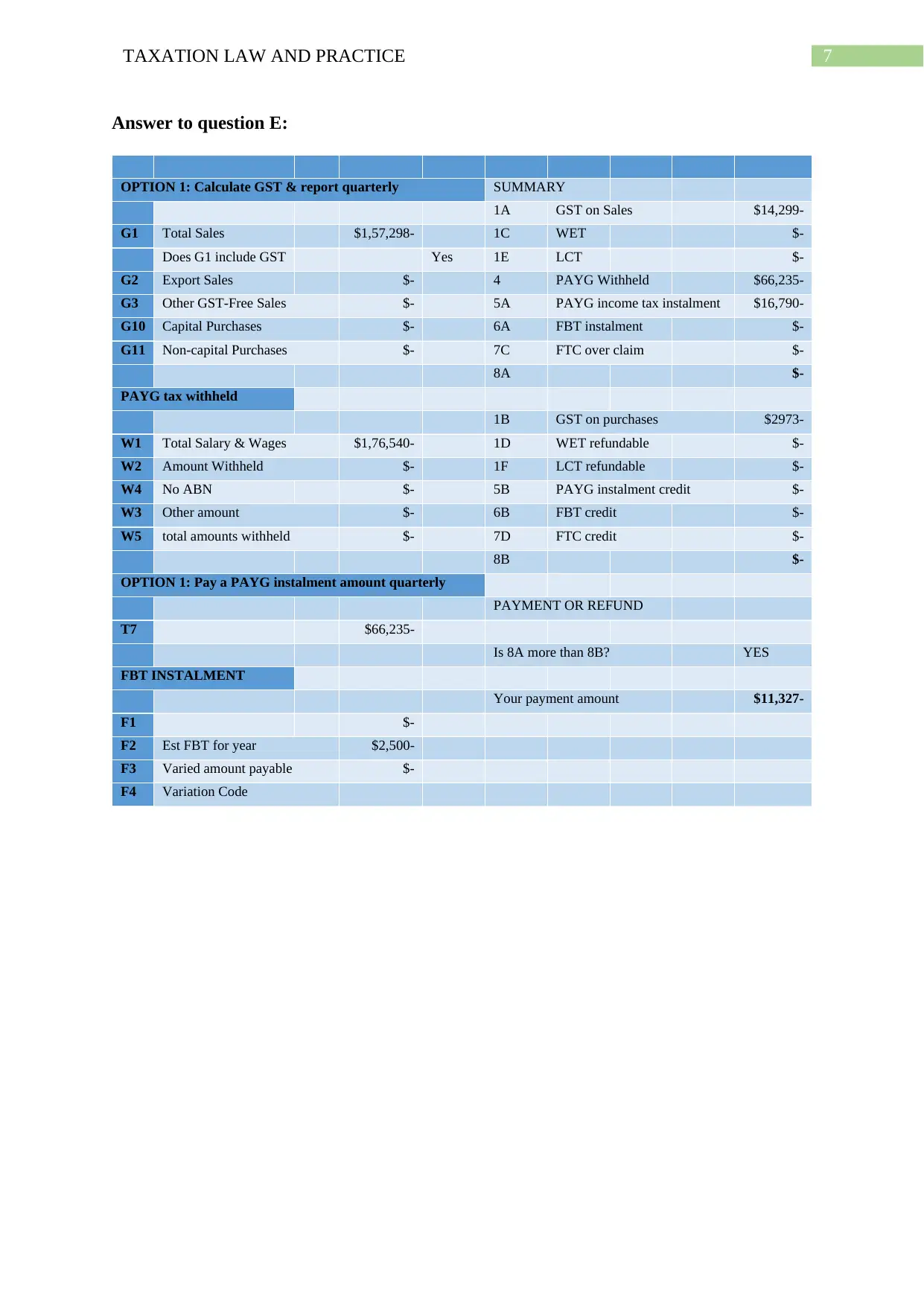
7TAXATION LAW AND PRACTICE
Answer to question E:
OPTION 1: Calculate GST & report quarterly SUMMARY
1A GST on Sales $14,299-
G1 Total Sales $1,57,298- 1C WET $-
Does G1 include GST Yes 1E LCT $-
G2 Export Sales $- 4 PAYG Withheld $66,235-
G3 Other GST-Free Sales $- 5A PAYG income tax instalment $16,790-
G10 Capital Purchases $- 6A FBT instalment $-
G11 Non-capital Purchases $- 7C FTC over claim $-
8A $-
PAYG tax withheld
1B GST on purchases $2973-
W1 Total Salary & Wages $1,76,540- 1D WET refundable $-
W2 Amount Withheld $- 1F LCT refundable $-
W4 No ABN $- 5B PAYG instalment credit $-
W3 Other amount $- 6B FBT credit $-
W5 total amounts withheld $- 7D FTC credit $-
8B $-
OPTION 1: Pay a PAYG instalment amount quarterly
PAYMENT OR REFUND
T7 $66,235-
Is 8A more than 8B? YES
FBT INSTALMENT
Your payment amount $11,327-
F1 $-
F2 Est FBT for year $2,500-
F3 Varied amount payable $-
F4 Variation Code
Answer to question E:
OPTION 1: Calculate GST & report quarterly SUMMARY
1A GST on Sales $14,299-
G1 Total Sales $1,57,298- 1C WET $-
Does G1 include GST Yes 1E LCT $-
G2 Export Sales $- 4 PAYG Withheld $66,235-
G3 Other GST-Free Sales $- 5A PAYG income tax instalment $16,790-
G10 Capital Purchases $- 6A FBT instalment $-
G11 Non-capital Purchases $- 7C FTC over claim $-
8A $-
PAYG tax withheld
1B GST on purchases $2973-
W1 Total Salary & Wages $1,76,540- 1D WET refundable $-
W2 Amount Withheld $- 1F LCT refundable $-
W4 No ABN $- 5B PAYG instalment credit $-
W3 Other amount $- 6B FBT credit $-
W5 total amounts withheld $- 7D FTC credit $-
8B $-
OPTION 1: Pay a PAYG instalment amount quarterly
PAYMENT OR REFUND
T7 $66,235-
Is 8A more than 8B? YES
FBT INSTALMENT
Your payment amount $11,327-
F1 $-
F2 Est FBT for year $2,500-
F3 Varied amount payable $-
F4 Variation Code
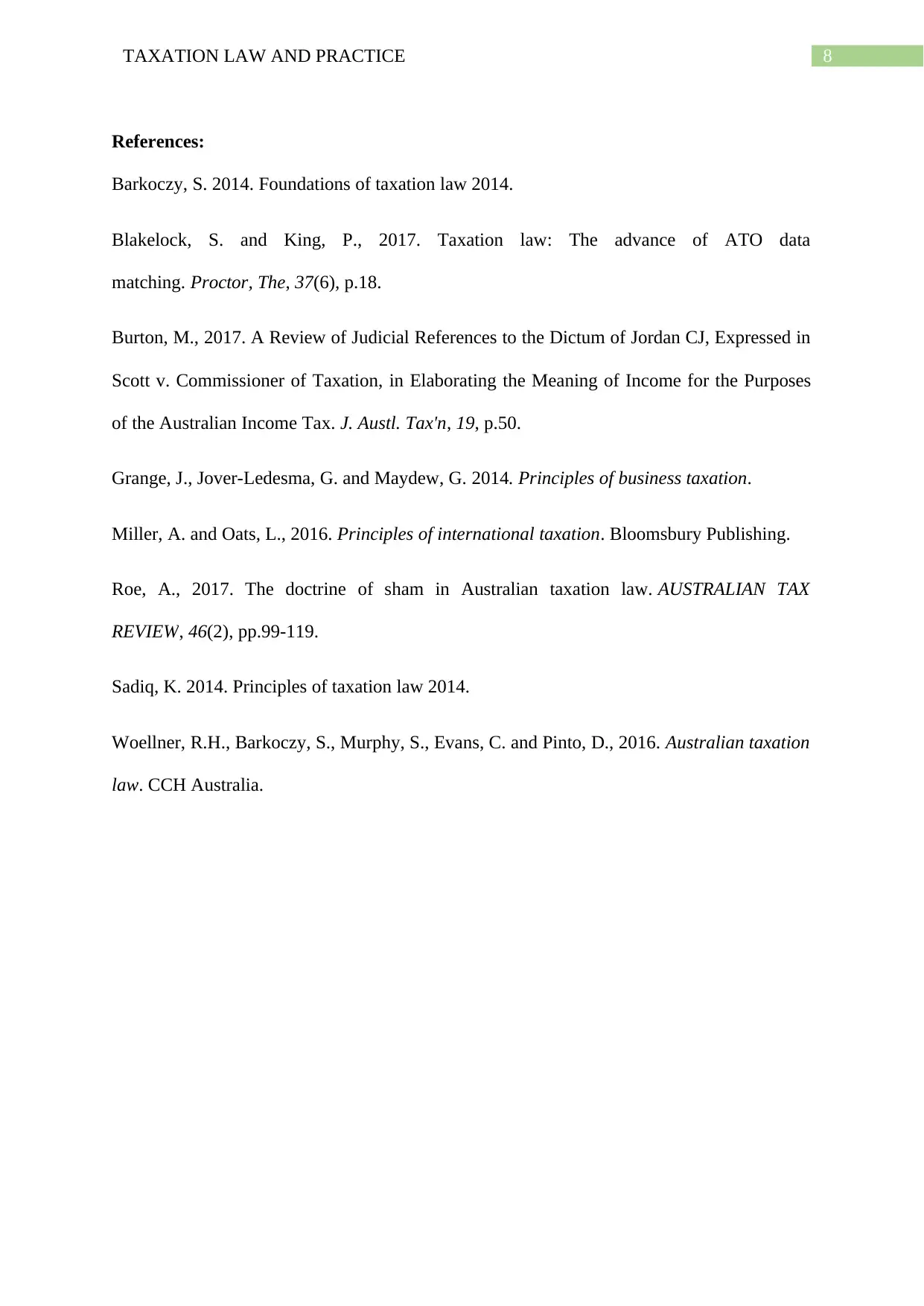
8TAXATION LAW AND PRACTICE
References:
Barkoczy, S. 2014. Foundations of taxation law 2014.
Blakelock, S. and King, P., 2017. Taxation law: The advance of ATO data
matching. Proctor, The, 37(6), p.18.
Burton, M., 2017. A Review of Judicial References to the Dictum of Jordan CJ, Expressed in
Scott v. Commissioner of Taxation, in Elaborating the Meaning of Income for the Purposes
of the Australian Income Tax. J. Austl. Tax'n, 19, p.50.
Grange, J., Jover-Ledesma, G. and Maydew, G. 2014. Principles of business taxation.
Miller, A. and Oats, L., 2016. Principles of international taxation. Bloomsbury Publishing.
Roe, A., 2017. The doctrine of sham in Australian taxation law. AUSTRALIAN TAX
REVIEW, 46(2), pp.99-119.
Sadiq, K. 2014. Principles of taxation law 2014.
Woellner, R.H., Barkoczy, S., Murphy, S., Evans, C. and Pinto, D., 2016. Australian taxation
law. CCH Australia.
References:
Barkoczy, S. 2014. Foundations of taxation law 2014.
Blakelock, S. and King, P., 2017. Taxation law: The advance of ATO data
matching. Proctor, The, 37(6), p.18.
Burton, M., 2017. A Review of Judicial References to the Dictum of Jordan CJ, Expressed in
Scott v. Commissioner of Taxation, in Elaborating the Meaning of Income for the Purposes
of the Australian Income Tax. J. Austl. Tax'n, 19, p.50.
Grange, J., Jover-Ledesma, G. and Maydew, G. 2014. Principles of business taxation.
Miller, A. and Oats, L., 2016. Principles of international taxation. Bloomsbury Publishing.
Roe, A., 2017. The doctrine of sham in Australian taxation law. AUSTRALIAN TAX
REVIEW, 46(2), pp.99-119.
Sadiq, K. 2014. Principles of taxation law 2014.
Woellner, R.H., Barkoczy, S., Murphy, S., Evans, C. and Pinto, D., 2016. Australian taxation
law. CCH Australia.
⊘ This is a preview!⊘
Do you want full access?
Subscribe today to unlock all pages.

Trusted by 1+ million students worldwide
1 out of 9
Related Documents
Your All-in-One AI-Powered Toolkit for Academic Success.
+13062052269
info@desklib.com
Available 24*7 on WhatsApp / Email
![[object Object]](/_next/static/media/star-bottom.7253800d.svg)
Unlock your academic potential
Copyright © 2020–2025 A2Z Services. All Rights Reserved. Developed and managed by ZUCOL.




